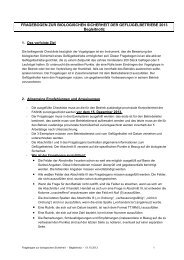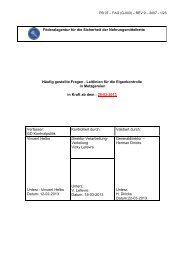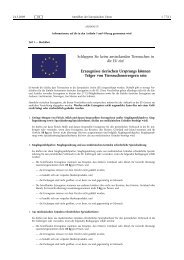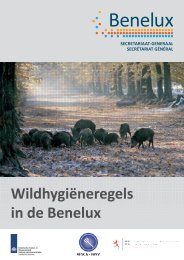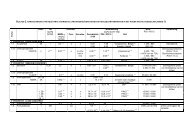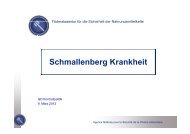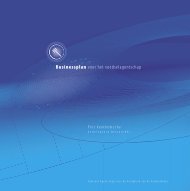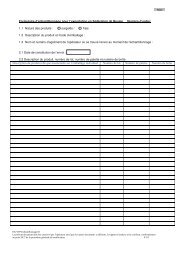Controls of pesticide residues in food and feed - Belgium 2011 - Favv
Controls of pesticide residues in food and feed - Belgium 2011 - Favv
Controls of pesticide residues in food and feed - Belgium 2011 - Favv
Create successful ePaper yourself
Turn your PDF publications into a flip-book with our unique Google optimized e-Paper software.
<strong>Controls</strong> <strong>of</strong> <strong>pesticide</strong> <strong>residues</strong> <strong>in</strong> <strong>food</strong><br />
<strong>and</strong> <strong>feed</strong> - <strong>Belgium</strong> <strong>2011</strong><br />
Results <strong>of</strong> the <strong>of</strong>ficial controls <strong>in</strong> accordance to Regulation (CE)<br />
N°396/2005 <strong>and</strong> Commission Regulation (EC) N° 915/2010<br />
Octobre 2012
PESTICIDE RESIDUE CONTROL RESULTS<br />
“NATIONAL SUMMARY REPORT”<br />
Country: BELGIUM<br />
Year: <strong>2011</strong><br />
National competent authority/organisation:<br />
FEDERAL AGENCY FOR THE SAFETY OF THE FOOD CHAIN (FASFC)<br />
Web address where the national annual report is published:<br />
http://www.afsca.be
1. OBJECTIVE AND DESIGN OF THE NATIONAL CONTROL PROGRAMME<br />
The use <strong>of</strong> plant protection products dur<strong>in</strong>g the production <strong>of</strong> fruit, vegetables <strong>and</strong> cereals can lead to<br />
the presence <strong>of</strong> <strong>residues</strong> <strong>in</strong> <strong>food</strong> <strong>and</strong> <strong>feed</strong>. Maximum residue levels (MRL) are set <strong>in</strong> the European<br />
legislation 1 <strong>in</strong> order to check the good use <strong>of</strong> plant protection products (use <strong>of</strong> authorised products<br />
accord<strong>in</strong>g to their authorization) <strong>and</strong> to protect the consumers. Food or <strong>feed</strong> which do not comply with<br />
the MRL cannot be put on the market. An MRL exceed<strong>in</strong>g content is the sign <strong>of</strong> <strong>in</strong>correct use <strong>of</strong> a<br />
plant protection product but does not necessarily <strong>in</strong>volve a risk for the health <strong>of</strong> consumers.<br />
The approach used by the Federal Agency for the Safety <strong>of</strong> the Food Cha<strong>in</strong> (FASFC) for the control <strong>of</strong><br />
<strong>pesticide</strong> <strong>residues</strong> is risk based. The programme is drawn up follow<strong>in</strong>g the general statistical approach<br />
developed with<strong>in</strong> the FASFC 2 . Several factors are taken <strong>in</strong>to account: the toxicity <strong>of</strong> the active<br />
substances, <strong>food</strong> consumption statistics, <strong>food</strong> commodities with a high <strong>residues</strong>/non-compliance rate<br />
<strong>in</strong> previous monitor<strong>in</strong>g years, orig<strong>in</strong> <strong>of</strong> <strong>food</strong> (domestic, EU or third country), RASFF notifications <strong>and</strong><br />
other useful <strong>in</strong>formation.<br />
All groups <strong>of</strong> fruits <strong>and</strong> vegetables are <strong>in</strong>cluded <strong>in</strong> the programme <strong>and</strong> a rotation programme is applied<br />
for less important commodities. The coord<strong>in</strong>ated control programme 3 <strong>of</strong> the European Commission<br />
<strong>and</strong> some targeted sampl<strong>in</strong>g (ma<strong>in</strong>ly targeted sampl<strong>in</strong>g at border controls accord<strong>in</strong>g to Regulation<br />
669/2009 4 ) are also <strong>in</strong>cluded <strong>in</strong> the national programme.<br />
Adjustments <strong>of</strong> the programme can be made <strong>in</strong> the course <strong>of</strong> the year so that emerg<strong>in</strong>g problems can<br />
be dealt with.<br />
The FASFC determ<strong>in</strong>es the target <strong>pesticide</strong>s for each sample type accord<strong>in</strong>g to a risk based approach<br />
tak<strong>in</strong>g <strong>in</strong>to account the active substances authorised <strong>in</strong> <strong>Belgium</strong>, the result <strong>of</strong> previous control<br />
programmes <strong>in</strong> <strong>Belgium</strong> <strong>and</strong> other Member States, the RASFF <strong>and</strong> the analytical possibilities.<br />
Sampl<strong>in</strong>g is done <strong>in</strong> accordance with Directive 2002/63/EC 5 that has been implemented <strong>in</strong> Belgian<br />
legislation. Samples are analysed <strong>in</strong> ISO 17025 accredited laboratories by means <strong>of</strong> multi-<strong>residues</strong> <strong>and</strong><br />
s<strong>in</strong>gle-<strong>residues</strong> methods which allowed <strong>in</strong> <strong>2011</strong> the detection <strong>of</strong> more than 600 <strong>pesticide</strong> <strong>residues</strong> <strong>and</strong><br />
metabolites.<br />
1 Regulation (EC) N°396/2005 <strong>of</strong> the EU Parliament <strong>and</strong> the Council <strong>of</strong> 23 February 2005 on maximum residue<br />
levels <strong>of</strong> <strong>pesticide</strong>s <strong>in</strong> or on <strong>food</strong> <strong>and</strong> <strong>feed</strong> <strong>of</strong> plant <strong>and</strong> animal orig<strong>in</strong><br />
2 Maudoux J-P., Saegerman C., Rettigner C., Hou<strong>in</strong>s G., Van Huffel X. & Berkvens D., Food safety surveillance<br />
by a risk based control programm<strong>in</strong>g: approach applied by the Belgian federal agency for the safety <strong>of</strong> the <strong>food</strong><br />
cha<strong>in</strong> (FASFC), Vet. Quart. 2006, 28(4): 140-154. http://www.favv-afsca.fgov.be/publicationsthematiques/<strong>food</strong>safety.asp<br />
3 Commission Regulation (EU) N° 915/2010 <strong>of</strong> 12 October 2010 concern<strong>in</strong>g a coord<strong>in</strong>ated multiannual control<br />
programme <strong>of</strong> the Union for <strong>2011</strong>, 2012 <strong>and</strong> 2013 to ensure compliance with maximum levels <strong>of</strong> <strong>and</strong> to assess<br />
the consumer exposure to <strong>pesticide</strong> <strong>residues</strong> <strong>in</strong> <strong>and</strong> on <strong>food</strong> <strong>of</strong> plant <strong>and</strong> animal orig<strong>in</strong><br />
4 Regulation (EC) N°669/2009 <strong>of</strong> 24 July 2009 implement<strong>in</strong>g Regulation (EC) No 882/2004 <strong>of</strong> the European<br />
Parliament <strong>and</strong> <strong>of</strong> the Council as regards the <strong>in</strong>creased level <strong>of</strong> <strong>of</strong>ficial controls on imports <strong>of</strong> certa<strong>in</strong> <strong>feed</strong> <strong>and</strong><br />
<strong>food</strong> <strong>of</strong> non-animal orig<strong>in</strong><br />
5 Commission Directive 2002/63/EC <strong>of</strong> 11 July 2002 establish<strong>in</strong>g Community methods <strong>of</strong> sampl<strong>in</strong>g for the<br />
<strong>of</strong>ficial control <strong>of</strong> <strong>pesticide</strong> <strong>residues</strong> <strong>in</strong> <strong>and</strong> on products <strong>of</strong> plant <strong>and</strong> animal orig<strong>in</strong> <strong>and</strong> repeal<strong>in</strong>g Directive<br />
79/700/EEC
2. KEY FINDINGS, INTERPRETATION OF THE RESULTS AND COMPARABILITY WITH THE<br />
PREVIOUS YEAR RESULTS<br />
In <strong>2011</strong>, a total number <strong>of</strong> 3320 samples <strong>of</strong> fruits, vegetables, cereals, animal products <strong>and</strong> processed<br />
products (<strong>in</strong>clud<strong>in</strong>g baby <strong>food</strong>) were taken by the Federal Agency for the Safety <strong>of</strong> the Food Cha<strong>in</strong><br />
(FASFC) <strong>and</strong> analysed for the presence <strong>of</strong> <strong>pesticide</strong> <strong>residues</strong>. The products analysed were <strong>of</strong> Belgian<br />
orig<strong>in</strong> (44,5%), EU orig<strong>in</strong> (17%), non-EU orig<strong>in</strong> (36%) <strong>and</strong> unknown orig<strong>in</strong> (2,5%).<br />
Table 1 summarises the results with respect to the sampl<strong>in</strong>g strategy.<br />
Table 1 : Products analysed for <strong>pesticide</strong> <strong>residues</strong> <strong>in</strong> <strong>2011</strong> with respect to the sampl<strong>in</strong>g strategy<br />
Sampl<strong>in</strong>g Samples Analysed without with <strong>residues</strong> > MRL<br />
strategy<br />
<strong>residues</strong> at or below<br />
MRL<br />
6 >MRL 7<br />
(Non<br />
compliant)<br />
Surveillance Fruit & vegetables 1891 566<br />
(29,9%)<br />
Cereals 30 7<br />
(23,3%)<br />
Processed products 115 71<br />
(<strong>food</strong>)<br />
(61,7%)<br />
Animal products 8 519 389<br />
(75%)<br />
Baby <strong>food</strong> 74 70<br />
(94,6%)<br />
Feed 94 55<br />
(58,5%)<br />
2723 1158<br />
(42,5%)<br />
Enforcement Fruit, vegetables &<br />
cereals<br />
Surveillance sampl<strong>in</strong>g<br />
594 223<br />
(37,6%)<br />
1216 (64,3%) 109 (5,8%) 51 (2,7%)<br />
21 (70%) 2 (6,7%) 2 (6,7%)<br />
43 (37,4%) 1 (0,9%) 0%<br />
130 (25%) 0% 0%<br />
3 (4,1%) 1 (1,3%) 0%<br />
38 (40,4%) 1 (1,1%) 0%<br />
1451 (53,3%) 114 (4,2%) 53 (1,9%)<br />
299 (50,3%) 72 (12,1%) 43 (7,2%)<br />
Feed 3 3 (100%) 0% 0% 0%<br />
597 226<br />
(37,8%)<br />
299 (50,1%) 72 (12,1%) 42 (7%)<br />
TOTAL 3320 1384<br />
(41,7%)<br />
1750 (52,7%) 186 (5,6%) 95 (2,9%)<br />
2723 surveillance samples were analysed with<strong>in</strong> the context <strong>of</strong> the control programme. 98,1%<br />
were compliant with the legislation <strong>in</strong> force.<br />
Ma<strong>in</strong> MRL violations were observed <strong>in</strong> legume vegetables (peas from Kenya & lentils ma<strong>in</strong>ly<br />
from France), <strong>in</strong>fusions (among others from Ch<strong>in</strong>a) <strong>and</strong> leafy vegetables (fresh herbs, sp<strong>in</strong>ach,<br />
endive <strong>and</strong> rucola ma<strong>in</strong>ly from <strong>Belgium</strong>). All samples <strong>of</strong> processed products, baby<strong>food</strong>, <strong>feed</strong> <strong>and</strong><br />
animal products were compliant. The list <strong>of</strong> MRL exceedances is available found <strong>in</strong> table D <strong>of</strong> the<br />
summary report.<br />
6 Measurement uncerta<strong>in</strong>ty is not taken <strong>in</strong>to account (numerical MRL exceedances)<br />
7 Measurement uncerta<strong>in</strong>ty is taken <strong>in</strong>to account (samples non compliant)<br />
8 Some animal products were analysed <strong>in</strong> the framework <strong>of</strong> Council Directive 96/23/EC <strong>of</strong> 29 April 1996 on<br />
measures to monitor certa<strong>in</strong> substances <strong>and</strong> <strong>residues</strong> there<strong>of</strong> <strong>in</strong> live animals <strong>and</strong> animal products
As <strong>in</strong> previous years, more MRL violations were proportionally observed <strong>in</strong> non-EU products<br />
(3,9%) than <strong>in</strong> products grown <strong>in</strong> BE (1,2%) or the EU (1,8%) (see table A0 <strong>of</strong> the summary<br />
report). The situation <strong>of</strong> non-EU products has however improved when compared to 2010 (-1,1%)<br />
In comparison with previous years, the number <strong>of</strong> samples reported has <strong>in</strong>creased (+24%<br />
compared with 2010). This <strong>in</strong>crease is expla<strong>in</strong>ed by the report<strong>in</strong>g <strong>of</strong> samples <strong>of</strong> animal orig<strong>in</strong><br />
analysed <strong>in</strong> the framework <strong>of</strong> Directive 96/23/EC which were not <strong>in</strong>cluded <strong>in</strong> the report <strong>of</strong><br />
previous years. This <strong>in</strong>crease has to be kept <strong>in</strong> m<strong>in</strong>d when compar<strong>in</strong>g the results with previous<br />
years. The total rate <strong>of</strong> MRL violations <strong>in</strong> <strong>2011</strong> is lower <strong>in</strong> comparison with 2010 (-0,2%). The<br />
rate <strong>of</strong> MRL violations <strong>in</strong> fruit <strong>and</strong> vegetables is however slightly higher <strong>in</strong> comparison with 2010<br />
(+0,3%) but equivalent to 2009.<br />
Enforcement sampl<strong>in</strong>g<br />
597 enforcement samples were analysed <strong>in</strong> the case <strong>of</strong> suspicion about the non compliance <strong>of</strong> a<br />
product with EU MRLs. These products were ma<strong>in</strong>ly targeted products analysed accord<strong>in</strong>g to<br />
Regulation 669/2009 (products com<strong>in</strong>g ma<strong>in</strong>ly from Thail<strong>and</strong>, the Dom<strong>in</strong>ican Republic, Egypt <strong>and</strong><br />
Ch<strong>in</strong>a) <strong>and</strong> products analysed with<strong>in</strong> the context <strong>of</strong> follow<strong>in</strong>g up <strong>of</strong> violations found previously.<br />
93% were compliant with the legislation<br />
Ma<strong>in</strong> MRL violations were observed <strong>in</strong> fresh m<strong>in</strong>t from Morocco (26% <strong>of</strong> the 45 samples<br />
analysed). MRL exceedances were also found <strong>in</strong> products from the Dom<strong>in</strong>ican Republic ((chilli-)<br />
peppers, beans & auberg<strong>in</strong>es) <strong>and</strong> Thail<strong>and</strong> (cori<strong>and</strong>er, basil & eggplants).<br />
Compared to previous years, the rate <strong>of</strong> non-compliant enforcement samples observed <strong>in</strong> <strong>2011</strong> is<br />
lower than <strong>in</strong> 2010 (-3,6%). This can be expla<strong>in</strong>ed among others by the decrease <strong>of</strong> MRL<br />
violations for chilli peppers.<br />
3. NON-COMPLIANT SAMPLES: POSSIBLE REASONS, ARFD EXCEEDANCES AND ACTIONS<br />
TAKEN<br />
When non-compliant samples are identified, the batch is seized, if available, <strong>and</strong> prevented from<br />
enter<strong>in</strong>g the market. An assessment <strong>of</strong> the risk for consumers is performed on all non-compliant<br />
samples <strong>and</strong> the appropriate measures such as recall <strong>and</strong> RASFF notification are taken 9 .<br />
Follow-up action is taken to verify the violation <strong>and</strong> to identify its cause. When non-compliant<br />
samples are identified, the producer or importer is subject to enhanced control <strong>and</strong> an <strong>of</strong>ficial report is<br />
drawn up <strong>and</strong> sent to the legal department <strong>of</strong> the FASFC which proposes a f<strong>in</strong>e. If the f<strong>in</strong>e is not paid,<br />
or <strong>in</strong> case <strong>of</strong> repeated <strong>of</strong>fences, the matter is taken to court .<br />
Four RASFF messages were issued by <strong>Belgium</strong> <strong>in</strong> <strong>2011</strong> for <strong>pesticide</strong> <strong>residues</strong> <strong>in</strong> <strong>food</strong> <strong>and</strong> <strong>feed</strong> 10 .<br />
Notification<br />
fosthiazate (0.091 mg/kg - ppm) <strong>in</strong> Nicola potatoes from Spa<strong>in</strong> (bus<strong>in</strong>ess self-check<strong>in</strong>g)<br />
fluazifop-p (0.58 mg/kg - ppm) <strong>in</strong> broccoli from Italy (bus<strong>in</strong>ess self-check<strong>in</strong>g)<br />
unauthorised substance EPN (0.36 mg/kg - ppm) <strong>in</strong> cori<strong>and</strong>er leaves from Thail<strong>and</strong><br />
Ref. number<br />
<strong>2011</strong>.0905<br />
<strong>2011</strong>.0182<br />
<strong>2011</strong>.AQF<br />
omethoate <strong>and</strong> dimethoate (sum = 0.133 mg/kg - ppm) <strong>in</strong> auberg<strong>in</strong>e (eggplant) from Ug<strong>and</strong>a <strong>2011</strong>.0237<br />
anthraqu<strong>in</strong>one (18 mg/kg - ppm) <strong>in</strong> wheat fibre produced <strong>in</strong> the Netherl<strong>and</strong>s, with raw material from<br />
Pakistan (bus<strong>in</strong>ess self-check<strong>in</strong>g)<br />
<strong>2011</strong>.0979<br />
9 The actions to be taken when an MRL is exceeded are described <strong>in</strong> a procedure available on the website <strong>of</strong> the<br />
FASFC (http://www.afsca.be/publicationsthematiques/<strong>in</strong>ventaire-actions.asp).<br />
10 http://ec.europa.eu/<strong>food</strong>/<strong>food</strong>/rapidalert/rasff_portal_database_en.pr<strong>in</strong>t.htm
The cause <strong>of</strong> MRL violations is searched for as far as possible. The table below gives an overview <strong>of</strong><br />
MRL non compliances found <strong>in</strong> products <strong>of</strong> Belgian orig<strong>in</strong> <strong>in</strong> <strong>2011</strong> <strong>and</strong> the possible cause <strong>of</strong> the non<br />
compliance.<br />
Product Residue Reason for MRL non compliance Note<br />
Apples Bromopropylate GAP probably not respected The use <strong>of</strong> bromopropylate is no<br />
longer authorised <strong>in</strong> Europe.<br />
Celeriac Clomazon GAP probably not respected Use <strong>of</strong> clomazon authorised <strong>in</strong><br />
Celery Oxadixyl Contam<strong>in</strong>ation: <strong>residues</strong> result<strong>in</strong>g<br />
from the previous use <strong>of</strong> a <strong>pesticide</strong><br />
(soil <strong>residues</strong> taken up by<br />
succeed<strong>in</strong>g crops)<br />
celeriac<br />
MRL changed <strong>in</strong> 2012 <strong>in</strong> order<br />
to take this problem <strong>in</strong>to account<br />
Celery L<strong>in</strong>uron GAP probably not respected Use <strong>of</strong> l<strong>in</strong>uron authorised <strong>in</strong><br />
celery<br />
Celery Cyfluthr<strong>in</strong> GAP not respected Use <strong>of</strong> cyfluthr<strong>in</strong> not authorised<br />
<strong>in</strong> celery<br />
Ch<strong>in</strong>ese Haloxyfop (sum) GAP not respected Use <strong>of</strong> haloxyfop non-<br />
cabbage<br />
authorised on Ch<strong>in</strong>ese cabbage<br />
Chives Cyfluthr<strong>in</strong> GAP not respected Use <strong>of</strong> cyfluthr<strong>in</strong> not authorised<br />
<strong>in</strong> chives<br />
Currants Lambda-cyhalothr<strong>in</strong> GAP probably not respected Use <strong>of</strong> lambda-cyhalothr<strong>in</strong><br />
Fennel Prometryn GAP probably not respected<br />
authorised <strong>in</strong> currants<br />
Use <strong>of</strong> non- authorised <strong>pesticide</strong><br />
<strong>in</strong> all crops<br />
Infusions Bifenazate GAP not respected Use <strong>of</strong> haloxyfop not authorised<br />
Lamb’s<br />
lettuce<br />
Dieldr<strong>in</strong> (sum) Contam<strong>in</strong>ation: <strong>residues</strong> result<strong>in</strong>g<br />
from the previous use <strong>of</strong> a <strong>pesticide</strong><br />
(soil <strong>residues</strong> taken up by<br />
succeed<strong>in</strong>g crops)<br />
<strong>in</strong> <strong>in</strong>fusions<br />
Lentils Malathion GAP not respected use <strong>of</strong> non-authorised <strong>pesticide</strong><br />
<strong>in</strong> all crops<br />
Parsley Bitertanol GAP not respected Use <strong>of</strong> bitertanol not authorised<br />
<strong>in</strong> parsley<br />
Parsley Dithiocarbamates GAP probably not respected : Use <strong>of</strong> dithiocarbamates<br />
authorised <strong>in</strong> parsley<br />
Rucola Pymetroz<strong>in</strong>e GAP probably not respected Use <strong>of</strong> pymetroz<strong>in</strong>e authorised<br />
<strong>in</strong> rucola<br />
Rucola Thiacloprid GAP probably not respected Use <strong>of</strong> thiacloprid authorised <strong>in</strong><br />
rucola<br />
Sp<strong>in</strong>ach Dithiocarbamates GAP not respected Use <strong>of</strong> dithiocarbamates not<br />
authorised <strong>in</strong> sp<strong>in</strong>ach<br />
Sp<strong>in</strong>ach Iprodione GAP not respected use <strong>of</strong> iprodione not authorised<br />
<strong>in</strong> sp<strong>in</strong>ach
4. QUALITY ASSURANCE<br />
Country<br />
code<br />
Laboratory Name Laboratory<br />
Code<br />
BE CENTRE D’ECONOMIE<br />
RURALE –<br />
LABORATOIRE<br />
D’HORMONOLOGIE<br />
ANIMALE<br />
BE<br />
BE<br />
BE<br />
DE<br />
BE<br />
FEDERAAL<br />
LABORATORIUM VOOR<br />
DE<br />
VOEDSELVEILIGHEID<br />
TERVUREN<br />
CER<br />
FYTOLAB C.V.B.A. FYTOLAB<br />
LABORATOIRE<br />
FEDERAL POUR LA<br />
SECURITE<br />
ALIMENTAIRE LIEGE<br />
LUFA-ITL GmbH<br />
WETENSCHAPPELIJK<br />
INSTITUUT<br />
VOLKSGEZONDHEID<br />
(WIV) – INSTITUT<br />
SCIENTIFIQUE DE<br />
SANTE PUBLIQUE (ISP)<br />
NL GROND-, GEWAS- en<br />
MILIEU-<br />
LABORATORIUM<br />
“ZEEUWS<br />
VLAANDEREN” BV<br />
5. ADDITIONAL INFORMATION<br />
Accreditation<br />
Date<br />
073-TEST<br />
(version 10.2, dd<br />
2012-06-13)<br />
FLVVT 014-TEST<br />
(version 6.2, dd<br />
<strong>2011</strong>-12-14)<br />
LFSAL<br />
LUFA<br />
WIV-PEST<br />
057-TEST<br />
(version 10, dd<br />
2012-07-27)<br />
014-TEST<br />
(version 6.2, dd<br />
<strong>2011</strong>-12-14)<br />
D-PL-14082-01-<br />
00 (dd 2012-02-<br />
17)<br />
081-TEST<br />
(version 12, dd<br />
2012-03-13)<br />
ZEEUWS L201(dd 2012-<br />
07-20)<br />
Accreditation<br />
Body<br />
Participation <strong>in</strong><br />
pr<strong>of</strong>iciency tests or<br />
<strong>in</strong>terlaboratory<br />
tests<br />
BELAC EUPT-AO 06<br />
FAPAS (Test 0581)<br />
BELAC EUPT-C5/SRM6<br />
EUPT-C6<br />
EUPT-AO7<br />
FAPAS (Test 19132)<br />
CAO<br />
<strong>2011</strong>)<br />
FFSD (11-<br />
KDLL (PCB11-1;<br />
BELAC<br />
PCB11-2; PCB12-1)<br />
EUPT-AO 06<br />
EUPT-AO 07<br />
EUPT-FV 13<br />
EUPT-SRM7<br />
EUPT-SRM6<br />
EUPT-C5/SRM6<br />
EUPT-C5 (total)<br />
EUPT-C6<br />
FAPAS Test 0578)<br />
BELAC AGES<br />
<strong>2011</strong>)<br />
(PTPR-H<br />
DAkkS<br />
BIPEA (19G)<br />
EUPT-AO 06<br />
FAPAS (Test 0578 ;<br />
Test 0583)<br />
EUPT-FV14<br />
EUPT-C5/SRM6<br />
BELAC AGES (PTPR-H<br />
<strong>2011</strong>)<br />
EUPT-AO 06<br />
EUPT-FV 13<br />
EUPT-SRM6<br />
EUPT-C5 (total)<br />
RvA EUPT-FV 13<br />
EUPT-SRM6<br />
FAPAS (Test 19115;<br />
Test 19120; Test<br />
19121; Test 19124;<br />
Test 19125; Test<br />
19127; Test 19128)<br />
Only organic <strong>food</strong> analysed <strong>in</strong> the frame <strong>of</strong> the EU coord<strong>in</strong>ated programme are part <strong>of</strong> this<br />
report. Additional controls on organic <strong>food</strong> are carried out by the Belgian Regional Authorities<br />
which are <strong>in</strong> charge <strong>of</strong> organic production. The results <strong>of</strong> these controls are reported separately<br />
to the European Commission.
Website FASFC: http://www.afsca.be<br />
Contact po<strong>in</strong>t : <strong>pesticide</strong>.pc@afsca.be


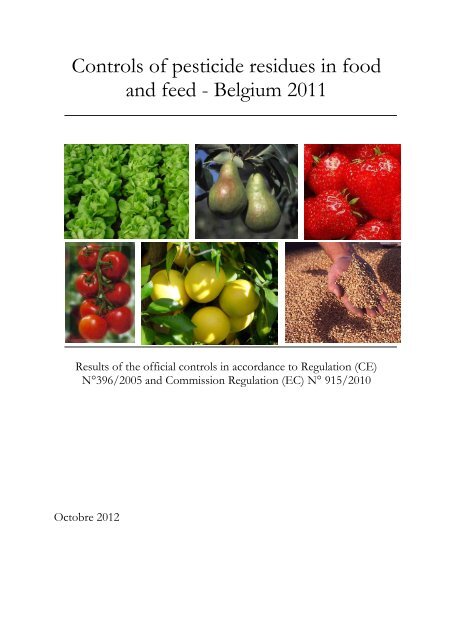
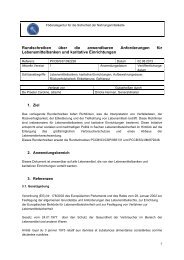
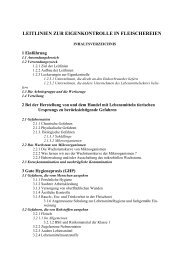

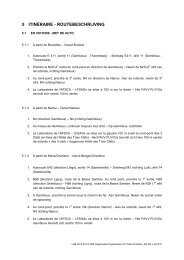
![DPA 2298 Schweine: Aujeszky-Impfung [2298] v2 - FAVV](https://img.yumpu.com/22032815/1/184x260/dpa-2298-schweine-aujeszky-impfung-2298-v2-favv.jpg?quality=85)
